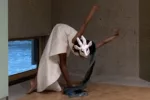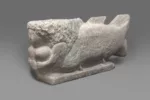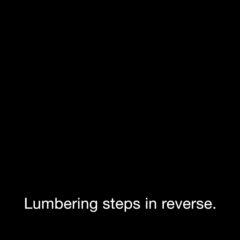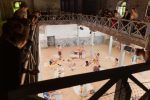The 2010 Philadelphia Live Arts and Fringe Festival is over, after sixteen days of nearly non-stop performances. As anticipated, Lucinda Childs’ Dance–a re-staging of the original piece of 1979–with film by Sol LeWitt and music by Philip Glass, was the exemplar to which all other avant-garde work should aspire. With Childs’ roots in the original “fringe” of conceptual artists at New York’s Judson Memorial Church in the early 1960s (which offered unconventional figures like Yoko Ono, Allan Kaprow, and Claes Oldenburg a place to show their work), these trailblazers all helped to redefine dance, music, theater, and the visual arts.
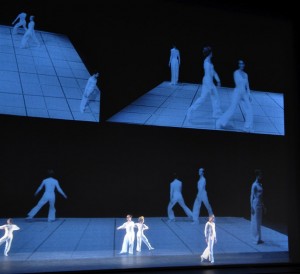
Surprisingly, the show’s three-day run at the Kimmel Center was not sold out, but its opening night was populated by the illuminati of Philadelphia’s cultural scene, all in agreement about the profound artistic experience they lauded with a prolonged standing ovation. Dance began at a breakneck pace and never relented, leaving the performers and audience breathless. The live dancers’ stylized symmetrical movements, choreographed by Childs, were performed behind a scrim, with silent video projections by LeWitt of the original troupe from1979, shot from a variety of floating angles, and set to the frenetic redundancies and variations of the score by Glass. The stark blue lighting, empty stage, and unadorned white costumes were in perfect accord with the collaborators’ less-is-more aesthetic; all elements were consistently subtle, hypnotic, visually impeccable, and flawlessly synchronized. This piece is a transcendent work that transports its viewers to a different plane.
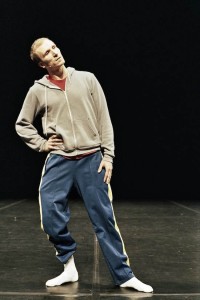
Another minimalist offering in dance was Jérôme Bel’s Cédric Andrieux. Presented as a live resumé, the solo eponymous dancer reviewed his career at an excruciatingly slow pace, with a soft-spoken humble demeanor bordering on insecurity. As a result, the audience experienced firsthand the tedium of seemingly endless auditions, warm-ups, and rehearsals, the impossible contortions and physical battering expected of professional dancers, and the brutally demoralizing criticisms they receive at the hands of their mentors. Each segment was followed by Andrieux trying to catch his breath, panting heavily into his headset for countless empty minutes. For me, he was sympathetic and engaging, with occasional understated touches of humor, as he imparted a behind-the-scenes glimpse of what it means to be a well-known well-toned dancer. Others seated around me found the 75-minute performance interminably boring and self-indulgent. Though the audience reaction was mixed, I found Andrieux’s delivery completely in tune with the message: it’s worth all the emotional and bodily torture for that moment of ecstasy onstage.
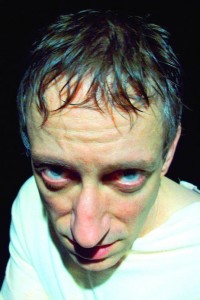
Two solo theatrical performances were also among my Top Picks for the Fringe, and they didn’t disappoint. Both Nevermore Theater Project’s The Tell-Tale Heart by Edgar Allen Poe and Luna Theater’s Thom Pain (based on nothing) by Will Eno were devastating studies of mental instability, acted with masterful intensity by John Zak and Christopher M. Bohan. Under the direction of Domenick Scudera, Zak, who has one of the most expressive faces in Philadelphia, drew us into the deteriorating mind of Poe’s fictional killer, from the carefully modulated and logical introduction to the increasingly agitated finale.
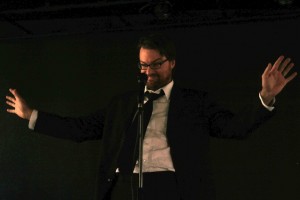
Bohan’s stand-up monologist Thom Pain was crazed and depressed, distracted and haunted; director Gregory Scott Campbell adeptly guided Bohan’s physical transformations through each bipolar cycle, from the wildly gesticulating arms and hands of his mania, to the downturned head and turned-in hands of his thoroughly dejected sadness, to the ambiguous twinkle in his eye and smile, as he expressed a final wish of “stability” for his audience. This is not theater for the fainthearted; it is powerful, disturbing, and uncompromisingly human. These heart-wrenching performances by Zak and Bohan will stay with me.
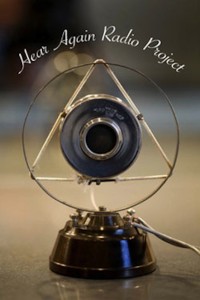
Lighter fare was provided by Plays and Players’ Hear Again Radio Project, a visual recreation of two 1950s radio dramas, replete with commercials and sound effects. Every detail of the now camp production was well researched and accurate, from the costumes, hairdos, and make-up, to the trained radio voices reading the vintage scripts. Staged in the Skinner Studio of Plays and Players’ historic building, it was an entertaining and nostalgic step back in time, even for those of us who are not of that time. A stand-out in the cast was the young Vayia Karavangelas, whose delivery and timing in Zero Hour were spot-on as the pre-teen accomplice to Martian invaders.
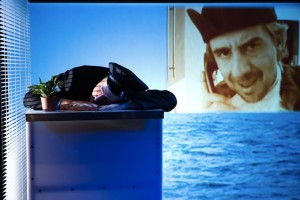
One of the most original new works in the Live Arts Festival was Lucidity Suitcase Intercontinental’s ¡El Conquistador! Supported by a cadre of Latin American telenovela stars filmed in Bogotá, Colombia, Thaddeus Phillips’ protagonist walked freely from live stage into (and out of) the well coordinated film clips, as he rose from rural poverty to the soap-opera life of a doorman in the big city, to a man of leisure at a beach resort, after escaping an assassination attempt and hitting the lottery! The exaggerated characters and outrageous plot twists, delivered completely in Spanish and derived in part from Hamlet and The Count of Monte Cristo, were hilarious.
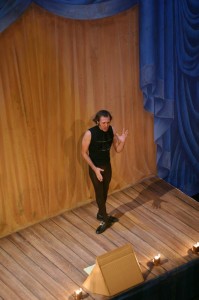
So too was Nature Theater of Oklahoma’s Romeo and Juliet, whose unique premise was to present Shakespeare’s classic based on a series of ten phone calls to people who were asked to recount the story. None could remember the exact details, so embellished, invented, and went off on personal tangents. Actors Robert M. Johanson and Anne Gridley alternately recited the telephone soliloquies verbatim, applying Elizabethan dialects and histrionics to the colloquial American versions. It was a stroke of comic genius that kept the audience in hysterics, and one of the funniest productions I’ve ever seen. The show closed with the stage and house lights going down, and the actors reciting Shakespeare’s true text in total darkness, in conversational tones without theatrics, faux English accents, or visual distractions. The contrast between the inarticulate telephone accounts and the exquisite beauty of Shakespeare’s language confirmed why he remains the world’s greatest playwright.
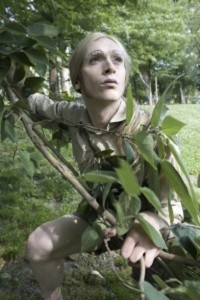
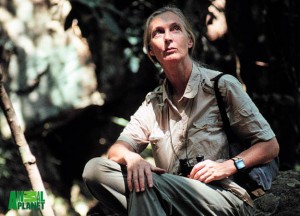
Visually and vocally, Marcel Williams Foster’s drag parody of anthropologist Jane Goodall in Hypen-Nation Arts’ The Jane Goodall: Experience was a comic delight. Though the story, writing, and music were not on par with Foster’s uncanny impersonation of his mentor in Tanzania, the promotional photos are stunning, and the production certainly fit the bill of “Fringe.” The running time, which was listed as 90 minutes in the Festival catalogue, was much shorter—presumably the show is still a work-in-progress, and worth the effort of reworking for future presentation.
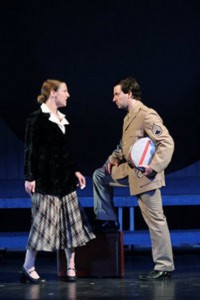
Another work-in-progress, by David Robson and John Stanton, presented free of charge as a reading, was Madhouse Theater Company’s Playing Leni (formerly titled Dysfictional Circumstances). Brilliantly performed by Colleen Corcoran, Robert DaPonte, and John Galla, the dark comedy about Hitler’s favorite filmmaker, Leni Riefenstahl, is clever, well-written, and thought-provoking. Conceived as a Riefenstahl-directed autobiographical film-within-a-play, and set in the Austrian countryside during her post-war capture and detention, it humorously raises serious questions about personal ethics, opportunism, self-preservation, and the accident of birth. Be sure to see the full-stage production in May 2011, in the new third floor space at the Adrienne, 2030 Sansom Street, Philadelphia.
Other established companies that extended their seasons into the Fringe and presented the most compelling and accomplished productions of the Festival were EgoPo and Theatre Exile. As my top picks of 2010-11, both succeeded in cementing their reputations as legitimate theaters on the cutting edge, featuring work by two of Philadelphia’s most outstanding directors, Brenna Geffers and Deborah Block.
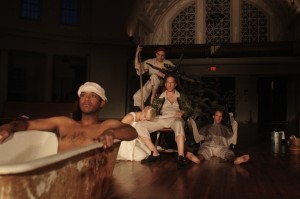
Geffers launched EgoPo’s “Theater of Cruelty” season with The Persecution and Assassination of Jean-Paul Marat as Performed by the Inmates of the Asylum of Charenton under the Direction of the Marquis de Sade. Staged in the University of Pennsylvania’s classical Rotunda of 1911, the dilapidated space was the perfect metaphor for the deteriorating state of the French Revolution, the sanity of the asylum’s inmates, and the morals of de Sade. There is no formal stage in the circular building, but the interior was used to full advantage by Geffers; actors appeared on the balcony for their impassioned revolutionary addresses to the crowds, and at floor level with the audience (seated just two rows deep in a semi-circle around the action), for an in-your-face intimacy and intensity. Led by award-worthy performances from David Blatt as de Sade, Steven Wright as Marat, and Jered McLenigan as the emcee, the ensemble of thirteen was consistently stellar, as was the original music by Mathew Wright and lighting by Matt Sharp.
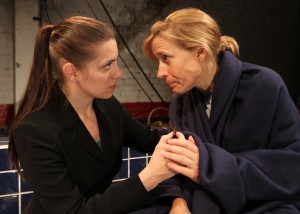
Block, too, gave us a tour-de-force of directing with Iron, converting Exile’s newly restored Studio X into a catwalk stage for the penetrating prison drama. Within inches of the audience, Catharine Slusar and Kim Carson not only mastered the requisite Scottish accents, but gave stirringly convincing performances as the estranged mother and daughter trying to come to terms with their lives and the past. The heartbreaking story of these strong and oddly sympathetic women provided no easy resolution, no politically correct excuses, no surprise ending; it was as real as theater can be, and deserving of the highest accolades. Even Caitlin Antram and Michael Hagan, playing the prison guards, remained in character throughout the performance, keeping close watch on the audience, and thereby giving us a brief taste of what imprisonment means.
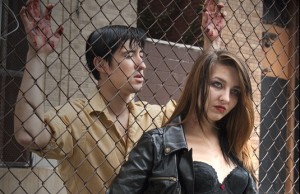
One additional production I had the good fortune to see was Polaroid Stories at the University of the Arts. An experimental combination of live actors, video, live music, and graffiti, the original play is an intelligent reworking of themes and characters from classical mythology, reconfigured as a lost generation of contemporary runaway kids (victims of abuse, drugs, poverty, and sexual exploitation), living their tragic lives in an urban hell. Participating students had the opportunity to work with professional actor Russ Widdall (one of Philadelphia’s finest, who gave a characteristically powerful performance), and sound designer Nick Rye (who created the show’s original music).
I hope the masses of attendees at the many sold out Festival productions continue to patronize Philadelphia’s small theater companies, many with tickets priced below those of the Fringe, and performance dates spread out at a leisurely pace over the entire 2010-11 season. Season subscriptions to EgoPo, Flashpoint, Inis Nua, Luna, New City Stage, and Theatre Exile, combined, total less than the Fringe’s $325 all-access pass. At those prices, and with their proven quality and professionalism, why not support Philadelphia’s outstanding theater scene throughout the year, not just for sixteen harried days?


